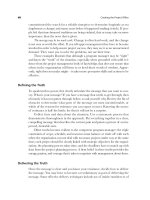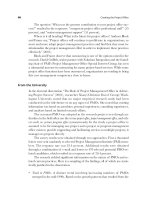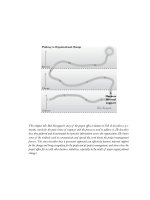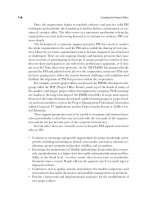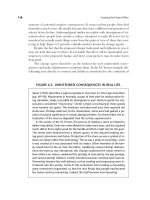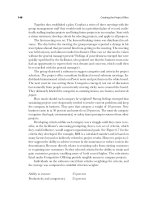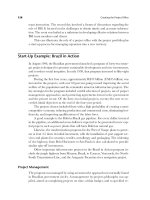Tài liệu Creating the project office 24 doc
Bạn đang xem bản rút gọn của tài liệu. Xem và tải ngay bản đầy đủ của tài liệu tại đây (68.43 KB, 10 trang )
area during start-up, the results showed lots of work to do. Some fixes were im-
plemented through focused training and dialogue on weak areas and then re-
assessed later in the year. One could make this a lifetime of work, but they do not
have the time, so they plan to use awareness of these issues as a selective mea-
surement for continuous improvement.
Results
The tremendous progress achieved since February 1999 includes the following
achievements:
• Kept the construction program going through the seventy-nine-day Kosovo air
campaign (March-June 99)
• Received final approval of the program and organizational plan (24 May)
• Met planned initial operating date (1 July)
• Completed a $6 million runway restoration project in just thirty-two days (August-
September 1999), which was necessitated by operational considerations and the
possibility of a Balkans follow-on air campaign
• Opened a $13 million, 150,000-square-foot commissary and base exchange
that is now the standard for worldwide consolidated stores for the military ser-
vices (November 2000)
• Won numerous design awards
• Successfully recovered when three construction contractors were terminated
for nonperformance, reprocuring the work in record time
LaGassey describes the PMO as “self-actualizing.” He adds,
Team members feel great about what they are doing, the responsibilities they
have, and their contributions to the program. Our reputation in the Air Force
goes all the way to the Chief of Staff in Washington, D.C. We’ve got applicant
lists a mile long of people who want to come to work here. We’ve had a num-
ber of our people “stolen” off with promotion offers. One Italian engineer who
had been with us only ten months was hired away at four times his current
salary to run the infrastructure effort at Bologna airport. He was one of seventy
applicants. He was told his Aviano 2000 experience pushed him to the top of
the list. Two sponsors in a row, Lt. Gen. Mike Short, who successfully ran the
Kosovo war from Aviano, and Lt. Gen. Ron Keys, the current commander,
16th Air Force, said many times that the Aviano 2000 program “would be dead
if it hadn’t been for the PMO.” The biggest flattery, of course, is that HQ
208 Creating the Project Office
USAFE has stood up two additional PMOs in Germany based on the success
model (and structure) of the Aviano PMO. Tangible value? We have proven
that to recover a program in trouble, a PMO is the only approach to take. The
kinds of challenges inherent in troubled programs can only be addressed with a
comprehensive, systematic, programmatic approach. Of course, it would have
been better to start with a PMO.
Program Assessment
LaGassey says, “We are in good shape.” And he can cite a lot of evidence for that
conclusion:
Our capabilities improve every day and our projects and program are matur-
ing. We are seeing more and more on-time, on-track projects. Customers are
pleased with what they are seeing in designs and construction. They feel more
involved in the process and in the eventual outcome. Things are looking up.
We’re achieving success.
Our program management approach was developed in house. Except for
hiring consultants for the project management information system and project
management training, we pretty much built our methodology by applying the
PMBOK Guide and other commercially available guidance. We burned a lot of
midnight oil trying to grasp all of it.
Ours was a task of piecing together the elements of project management,
extrapolating the right elements, applying them to our circumstances, and tai-
loring tools and resources for our situation. There has been a great deal of trial
and error and frequent worries that perhaps it’s not exactly the way the PMI
Grand Masters would have done it. So be it, it’s our program and our way of
doing it.
When asked, what would you now do differently if starting anew, LaGassey
responds,
If given the same state of play, that is, a troubled program that is five years
under way, I would approach it just a little differently. For one, I would be more
insistent in my battles to get the resources I need to get this thing off the ground
and make the program go. Because I was breaking new ground each day and
was not sure if it was going to work, I sometimes used kid gloves in my dealings
with those who had the resources I needed. As a result, they sometimes slow-
rolled me and I accepted it. With the experience I’ve gained, I now know that it
works and I don’t have to take no for an answer.
Keep Moving 209
Two, I would have pushed harder to clarify the roles and responsibilities
earlier and get them down on paper. We were making it happen, but I’ve seen
that getting buy-in is one of the hardest parts of making this work. When you
win a battle, you have to codify it. As time goes on and people transfer out, we
lose some of the history. A lot of how we do it (organization, processes, our PM
methodology, and so on) is in my head and we need to formalize them. If I
croak tomorrow, we don’t have it all nailed down. A PMP update (with signa-
tures) is on our strategic plan for 2002.
Third, I would institute a more effective personnel assessment program.
For the most part, I’ve been fortunate to have great people, but there are always
a couple who I would like to change out if given the opportunity. The trouble
with our system is that it takes lots of paper in the form of counselings and so
on to effect a change. Because of the “bullet train” nature of Aviano 2000,
such refinements weren’t possible at the outset, and now we don’t have the nec-
essary documentation to effect additional personnel changes I might want.
Lessons Learned
Catching up with a program that had been under way for five years was much
more difficult than anyone could have imagined. Achieving full operational ca-
pability meant assigned people, an organizational structure, processes and proce-
dures in place, money flowing, and projects being delivered. LaGassey achieved
some early successes, like the complete restoration of the runway in thirty-two
days. There were also a number of failures, for example, unacceptable delays
caused by nonperforming contractors. Many of those might have been resolved
earlier had a PMO been established from the start.
LaGassey says,
Simplicity is imperative in all we do and our program success continuum is no
exception. We have a tiger by the tail and, although we find all the current the-
oretical project management maturity models very interesting, the Aviano 2000
program team doesn’t have time right now to study and analyze them.
We recognized from the start that application of standardized PM prin-
ciples is critical for project management. Because of the imperative to start up
a program office so late in the game, we needed a simple, commonsense ap-
proach. At the project level, we quickly settled on selective use of principles
found in the PMBOK Guide because it was ready-made to help us. We figured
we could develop our initial approach and fill in gaps later. At the program
level, a considerable part of our approach was derived from the writings and
210 Creating the Project Office
teachings of Graham and Englund. Their 1997 book, Creating an Environment for
Successful Projects: The Quest to Manage Project Management, became our bible for
program leadership during PMO start-up and continues to be a fundamental
part of our thinking as we work to attain recognition as a truly project-based
organization.
We have learned hundreds of lessons from this experience of setting up
a PMO five years after the program began. It’s been a steep learning curve.
While we will undoubtedly continue to learn through program completion in
2005, this next year of our activity, as we begin construction of fifteen new
projects, will steeply accelerate our learning curve.
All stakeholders in the program are trained or oriented in the methodology,
principles, and techniques of project management. PM basic training tailored to
Aviano 2000 is given to each member, including customer representatives. This
training has been a real eye-opener for many, especially those who had never been
involved in large projects before. Core team members get specialized training on
software, partnering, leading teams, and the tools to be used. LaGassey says, “Our
capabilities and maturity have been increased a thousandfold because of training.”
What effect is this work having on the larger organization?
We are beginning to create a mind-set of project management as the only way
to do business. The successes of Aviano 2000 made believers out of those who
knew we needed change but didn’t know quite how to go about it. Now they
see the benefits to an organized, structured, focused approach. We purposely
included representatives of the user (customer) organizations during our PM
101 basic training as one step in the process, along with asking each of the
four groups in the fighter wing to have a standing representative of the colonel
group commander within the PMO. This has paid great dividends in spreading
the word. Our goal is to have everyone thinking the same way.
How is it being extended?
We’ve also made a point to include the leadership of our major customer
groups in quarterly program reviews. The 31st Fighter Wing structure is a
straight military hierarchy—chain of command. The senior commander is a
brigadier general. He’s the wing commander. Beneath him are four groups:
operations, logistics, medical, and support, each commanded by a full colonel.
Beneath the groups are the squadrons, mostly technical in nature, each with a
commander, usually a major or lieutenant colonel. There are about twenty
squadrons at Aviano. We included both group and squadron commanders as
Keep Moving 211
our target market because every squadron on the base has at least one major
construction project in the program. By creating “group representative” posi-
tions in the PMO, we formalized a channel for the group commanders to have
a direct voice in the process. That way, the group commanders’ concerns enter
the system without anyone having to talk to me except on the most pressing
issues. Each squadron in turn has “facility project managers” who are respon-
sible for defining requirements and working with our project delivery teams.
Everyone has a responsibility and a communications avenue.
The structure, training, reviews, and so on keep the project teams and
customers interlocked through the entire process. In essence, everyone has
ownership of a part of the process and in the final outcome.
Are other organizations adopting the same or a similar approach?
We are beginning to break through to other organizations on the base. Those
mostly closely related to the Aviano 2000 program team, for example, the navy
and the base civil engineer, embrace our PM methodology and use it routinely.
The Italian program team is eager to learn. Our customers understand the
principles and adapted to our way of managing the program. Whether all are
true believers remains to be seen. Our biggest challenge is turnover of person-
nel. The average assignment tour at Aviano is three years—commanders two;
therefore it’s a constant orientation and learning process.
Have you established a standard?
Yes—a standard approach to execution of the program, the organization, and
periodic reviews. We now speak the same language. When we talk about pro-
gram or project issues, everyone understands a common terminology, schedule
milestones and what they signify, requirements, and the project review grading
system. This applies from the top sponsors to where the rubber meets the road
at the project team member level. Our standard for success in terms of scope,
cost, time, quality, and safety are also deeply embedded in the system.
What is on the horizon?
Integrating the newly established Italian program team is our challenge for
2002. They are starting construction on ten projects and will be working
through all multiproject management procedures at once. One PMO objective
over the past two years was to put all organizational, structural, procedural,
and process systems in place so Italy could insert its team into the PMO and
212 Creating the Project Office
